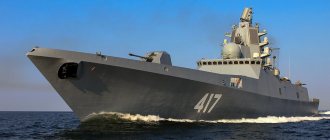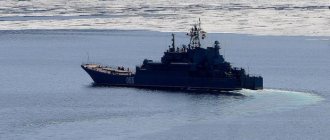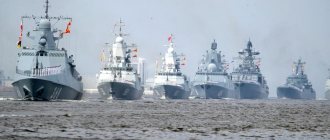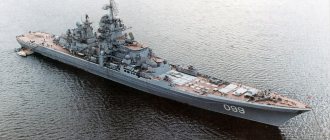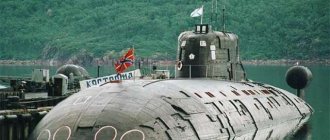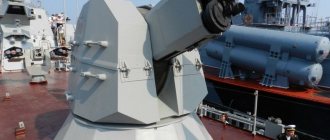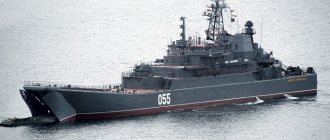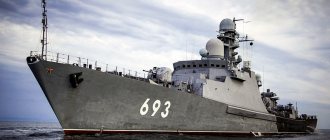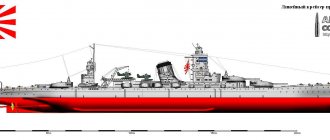Today, the Russian Navy is at the stage of re-equipment. The warships that Russia inherited from the Soviet Union have already fallen into disrepair. Of these, some of the old ones have been disposed of, and the other part must be modernized. They should be replaced by modern combat units - Project 22350 frigates.
Let's take a closer look at the history of the creation of ships, their tactical and technical characteristics, design, armament, description of the ship of the Admiral Kasatonov frigate project.
Modern frigate for the Russian fleet
The appearance of a frigate in the Russian fleet as a class of combat vessels is not a new phenomenon. Since the era of the sailing fleet, ships of this class have had the greatest amount of work. Russian frigates carried out combat duty and reconnaissance on the near approaches to coastal facilities, and took part in battles as part of linear forces. With the beginning of the era of the steam fleet, frigates, as a class of warships, were forced into the shadows. Cruisers took their place. For almost 50 years, frigates disappeared from view. Only after the end of the Second World War did it again come the turn of these ships to appear on the vast oceans. The new ships have firmly found their niche in the combat composition of foreign fleets, taking their place in the combat formation between destroyers and cruisers.
In the Soviet Union, unlike the fleets of other countries, there were no ships of the frigate class, since the classification of ships by purpose was adopted. The functions of the frigate were performed by patrol ships. In terms of their functional qualities and combat equipment, Soviet patrol ships were full-fledged combat vessels, capable of not only operating in the coastal zone, but also performing a wide range of tasks at a considerable distance from their own bases. After the collapse of the USSR, a reform was carried out in the Russian Navy that affected the classification of combat ships. All large anti-submarine patrol ships in the fleet were reclassified as frigates.
Russia began building new ships of this type only in the new millennium, when the old guard in the form of former BODs and Grozny-class missile cruisers finally gave up their positions.
The new Project 22350 frigates being commissioned should fill the gap that arose after the decommissioning of the Project 58 missile cruiser Admiral Golovko. It was this ship that became the last representative of the class of combat ships, which in their tactical and technical characteristics were more reminiscent of frigates. Modern domestic frigates should become a powerful striking element of the fleet, strengthening with their presence the combat readiness of the Russian fleet anywhere in the world's oceans.
In accordance with their tactical and technical characteristics, Project 22350 ships must have a cruising range of more than 4 thousand miles and a navigation endurance of 30 days. In terms of displacement and armament, the new ships are slightly inferior to the Slava-class missile cruisers, surpassing the latter in the level of protection, electronic equipment and fire control. The naval leadership plans to create a new powerful core of the high seas fleet from the new Project 22350 frigates.
Initially, it was planned to strengthen all Russian fleets with new combat units. However, in the future it was decided to concentrate on equipping the Black Sea Fleet with new vessels.
Why did it take so long for the Admiral Gorshkov to be commissioned?
The main problem, due to which we constantly had to reschedule, was the chronic delay in the delivery of individual systems. Yes, the cruiser “Admiral Gorshkov” was built by the St. Petersburg shipyard, but all the weapons, radar and sonar systems were provided by completely different contractors! It is they who bear the lion's share of responsibility for postponing the frigate's delivery date. In particular, air defense and hydroacoustics systems caused many problems. In addition, the supply of components for the new artillery system was disrupted a couple of times, without which the frigate Project 22350 Admiral Gorshkov would have been little superior to ships of a similar class.
Creation of project 22350 and construction program
In accordance with the old classification, the new ship was created as a patrol ship, designed to sail away from the main locations. As before, the development of the project was carried out by the Northern Design Bureau, one of the leading domestic enterprises in this area. In 2003, after modifications and correlation of design parameters with technical specifications, project number 22350 was approved by the Supreme Naval Leadership of the country.
In accordance with the state program, the project provided for the construction of 20 vessels of this type. The construction and commissioning of new frigates took 15-20 years. Construction is planned to be carried out at four shipyards: at the Baltic Shipyard, at the Kaliningrad Shipyard "Yantar", at the Northern Shipyard and at the Admiralty Shipyard in St. Petersburg.
The first contract for the construction of a Project 22350 frigate, under the terms of the tender, was won by PJSC Shipyard Severnaya Verf, at whose facilities the lead ship of the frigate series, Admiral Gorshkov, was laid down on February 1, 2006. Problems with the technical equipment of the new ship and the lengthy selection of the optimal weapon system for ships of this class led to the fact that Admiral Gorshkov took more than 4 years to build. The ship was launched on October 29, 2010, after which the Ministry of Defense signed two more contracts with St. Petersburg shipbuilders, in 2010 and 2011 for the construction of 7 ships of this project.
Severnaya Verf was selected as the sole and leading supplier of Project 22350 ships for the domestic fleet. All ships ordered for construction must enter service no earlier than 2022. In the future, it is planned to build ships according to the improved project 22350M.
The commissioning of the frigate Admiral Gorshkov was greatly delayed. To this day, the ship is undergoing state tests. From this moment on, interesting moments begin in the history of the program for the construction of combat ships of this class. The first ship of the series, the frigate Admiral Kasatonov, was laid down in 2009, but its final completion took even longer. Only in 2022 the ship was launched. Commissioning of the ship was expected only in 2022, subject to strict compliance with all terms of the contract.
In those years, there was an active debate on the Internet forum about what was the main reason for such a delay in the commissioning of new ships. There are differing opinions on this matter, but most likely, the main factor in such a long construction of both ships lies in the unsatisfied technical condition of the main ship components and assemblies.
Today you can find information on forums where it is reported that on the lead ship, the frigate Admiral Gorshkov, the main propulsion system failed during factory tests. Instead of repairs, it was decided to install a similar gas turbine engine removed from the second ship. The failed engine was planned to be sent for repairs and modifications, after which the donor wanted to install it on the ship.
For reference: The main propulsion engines for Project 22350 frigates were manufactured by the Ukrainian enterprise Zarya. In accordance with the decision of the RNBO of Ukraine, the supply of gas turbine units to equip Russian frigates has been stopped.
The development of analogues of the Ukrainian product has begun at NPO Saturn and should completely displace Ukrainian components from the design of Russian warships.
The latest news for 2020-2016 reports that the lead frigate of Project 22350 made a test passage from the Baltic to the White Sea, independently traveling more than 2 thousand nautical miles. At the test site, combat launches of anti-ship missiles were carried out from the ship, and tests of anti-aircraft missile systems were carried out. A final decision on whether to accept the ship into the active fleet is expected.
The second ship in the long-suffering series, the frigate Admiral Golovko, was laid down in 2012. The ship was named in honor of the famous Soviet naval commander Arseny Grigorievich Golovko and should continue the combat traditions of its predecessor, the Project 58 missile cruiser Admiral Golovko.
This warship, expelled from the fleet in 2002, continued to serve in the Black Sea for more than 30 years. In terms of displacement and type of armament, these ships most closely resemble modern frigates. Missile cruisers of the same type as the Admiral Golovko were entrusted with the task of performing combat missions and displaying the flag in different regions.
The launch of a new ship of the same name is planned for 2020. The latest news from the slipway indicates that the ship is only 50% ready. In addition, the delivery of the gas turbine propulsion system by NPO Saturn within the specified time frame is in question.
The third ship of the series “Admiral of the Fleet of the Soviet Union Isakov” was laid down at the Northern Shipyard in November 2013. As with previous Project 22350 ships, the issue of timely commissioning of the combat unit is in question.
Distinctive features
The good thing about the ship is that it is designed to operate in both near and far sea zones, as well as for combat operations in oceanic conditions. Displacement is approximately 4,500 tons, maximum length is at least 130 m, hull width at its widest point is 16 meters. The length of the voyage is more than four thousand nautical miles, the sailing season is unlimited. In addition to powerful artillery and missile weapons, there is a platform for receiving a combat helicopter (Ka-28).
Among other things, the frigate “Admiral Gorshkov” is unique in that at least 30% of completely new technologies and materials were used in its design. Competing with the Americans, the aft superstructure and wheelhouse were created using stealth technology, which ensures strong dispersion of radar waves, guaranteeing the ship a high degree of stealth. It is not surprising that the degree of secrecy during its design was “at the level”: only designers and shipbuilders knew about the appearance of the Admiral. Nothing was leaked to the press until the launch.
Performance characteristics
For obvious reasons, most of these characteristics are unknown to the general public, and should not be known. However, many people are familiar with some general characteristics of the ships under construction from the new series:
- The hull is equipped with side stabilizers, the rudders of which will not be retracted. This device is necessary to ensure that the ship does not lose its performance during a storm;
- The superstructures will be made of special materials with composite characteristics. Such materials help reduce the radio-acoustic background of ships;
- The frigates will be equipped with Stealth technology. This technology makes ships stealthy, preventing enemy radars from detecting them;
- All will have a double bottom, which will help the ships stay afloat if damage occurs;
- A universal fire extinguishing system will be installed;
- The power of the propulsion system will reach 55 thousand horsepower;
- The maximum speed will reach 29 knots;
- Using economic propulsion (14 knots), the frigate will be able to travel 4,000 miles without stopping.
Most likely, when testing new ships, some of their initial characteristics will change.
Power point
In general, there is nothing surprising about it: a diesel gas turbine unit with a power of about 65,000 hp. It belongs to the CODAG type, the diesel engine itself belongs to the DHTA-M55MR family (all in one housing). This design solution made it possible to combine both high maximum power and the best efficiency when moving at low speed (sea trials of the frigate Admiral Gorshkov clearly proved this).
The gas turbine unit is located in the bow compartment, while the diesel engine is traditionally located at the stern.
Armament of Project 22350 ships
The new ships are planned to be equipped with the most modern weapons:
- The most powerful armament of the frigates is expected to be the 16 Moskit anti-ship missile launcher;
- In addition, the vessels will be equipped with the A-192 universal automatic artillery mount;
- To destroy enemy submarines, the ships will be armed with Medvedka-2 anti-submarine systems;
- To assess the hydroacoustic underwater space, frigates are equipped with a special Vignette-M system. This system allows you to hear an enemy submarine at a distance of up to 60 kilometers;
- To protect themselves from air attack, they will use the Redut anti-aircraft missile system;
- For the same purpose, as well as for hitting unobtrusive targets on the surface of the water, they will be equipped with the Broadsword missile and gun system;
- All ships of this project must also have Ka-27 helicopters with the ability to take off and land on deck.
Again, it is quite obvious that in the future the ships’ armament can be supplemented or changed.
Some results
Generally speaking, the Admiral of the Fleet Gorshkov is a frigate, in many ways a fairly typical representative of the Soviet-Russian shipbuilding school. However, for the first time in the history of our fleet, missile weapons are placed in silos on a surface ship. By the way, our American “colleagues” have long come to the need for just such a placement of this type of weapons, since in this case it is possible to eliminate the “zoo” of launch facilities, which is so characteristic of the Soviet fleet. This will significantly reduce the cost of operating ships, since far fewer specialists will need to be trained.
Alas, the Russian Navy, until 2010, had no unification in this area at all. Moreover, each (!) missile system had its own specific application. The latter fact practically put an end to the idea of creating multifunctional ships. If our shipbuilding industry follows the path blazed by the Admiral Gorshkov ship, then the fleet will finally receive truly universal, flexible and powerful weapons that can be effectively used along the entire length of the Russian coastline.
